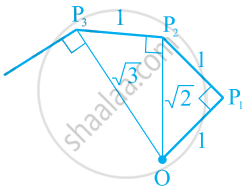Advertisements
Advertisements
प्रश्न
Given that `sqrt(3)` is irrational, prove that `5 + 2sqrt(3)` is irrational.
उत्तर
Let us assume `5 + 2sqrt(3)` is rational, then it must be in the form of `p/q` where p and q are co-prime integers and q ≠ 0
i.e. `5 + 2sqrt(3) = p/q`
So `sqrt(3) = (p - 5q)/(2q)` ......(i)
Since p, q, 5 and 2 are integers and q ≠ 0, RHS of equation (i) is rational. But LHS of (i) is `sqrt(3)` which is irrational. This is not possible.
This contradiction has arisen due to our wrong assumption that `5 + 2sqrt(3)` is rational.
So, `5 + 2sqrt(3)` is irrational.
संबंधित प्रश्न
In the following equation, find which variables x, y, z etc. represent rational or irrational number:
z2 = 0.04
Give two rational numbers lying between 0.515115111511115... and 0.535335333533335...
Give an example of two irrational numbers whose:
product is an rational number.
Prove that of the numbers `5 + 3 sqrt (2)` is irrational:
Find the square of : 3 + 2√5
Write the following in descending order:
`sqrt(6), root(3)(8) and root(4)(3)`
Between two rational numbers ______.
Find whether the variable u represents a rational or an irrational number:
`u^2 = 17/4`
Show that x is irrational, if x2 = 27.
Classroom activity (Constructing the ‘square root spiral’): Take a large sheet of paper and construct the ‘square root spiral’ in the following fashion. Start with a point O and draw a line segment OP1 of unit length. Draw a line segment P1 P2 perpendicular to OP1 of unit length. Now draw a line segment P2 P3 perpendicular to OP2. Then draw a line segment P3 P4 perpendicular to OP3. Continuing in this manner, you can get the line segment Pn–1Pn by drawing a line segment of unit length perpendicular to OPn–1. In this manner, you will have created the points P2, P3,...., Pn,.... ., and joined them to create a beautiful spiral depicting `sqrt2, sqrt3, sqrt4,` ...

